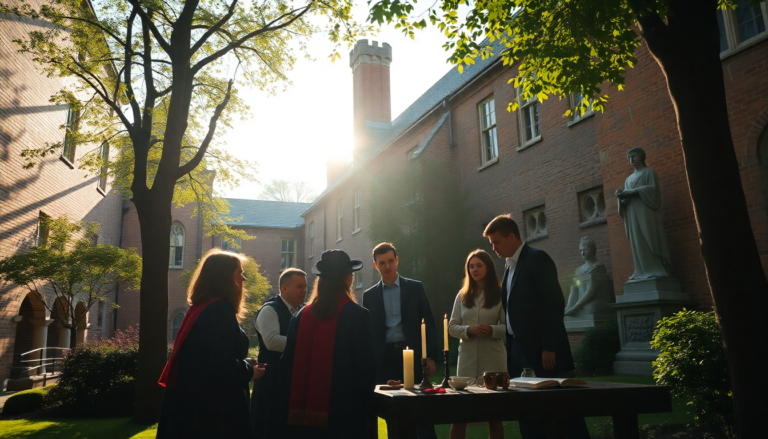Argomenti trattati
In the vibrant landscape of North American colleges and universities, secret societies have long captivated the imagination of students and outsiders alike. These organizations, often shrouded in mystery, boast a rich history and a unique set of traditions that bind members together in unspoken camaraderie. From their clandestine initiation rites to their exclusive membership rosters, collegiate secret societies play a significant role in shaping campus culture, leaving many curious about their inner workings.
Understanding collegiate secret societies
Collegiate secret societies are not just exclusive clubs; they are often intricate networks that promote social bonds, academic excellence, and sometimes even influence within the university. These societies vary in their level of secrecy, with some maintaining strict confidentiality regarding their members and activities, while others are somewhat more open. Interestingly, many of these societies are categorized as “class societies,” typically limited to students of a specific graduating class. Most commonly, these groups are made up of senior members, though some extend their reach to juniors, creating a unique dynamic among upperclassmen.
The defining characteristic of these societies is their secretive nature. Initiations may include unique rituals, secret handshakes, and even clandestine gatherings that only members are privy to. While traditional fraternities and sororities often have public membership, secret societies thrive on the allure of anonymity. Membership lists can remain confidential until graduation or, in some cases, until death. For instance, the renowned Skull and Bones society at Yale University has historically published its membership lists, yet many societies choose to keep their members’ identities under wraps.
The evolution of secret societies
The first collegiate secret society in North America, the F.H.C. Society, was founded in 1750 at The College of William & Mary, setting a precedent for future organizations. Over the years, many societies have emerged, each with its own traditions and characteristics. For example, Phi Beta Kappa, initially a secret society, evolved into a prestigious academic honor society, showcasing how some groups can transition from secrecy to recognition.
At Yale, the competition among secret societies led to the establishment of a unique hierarchy. Skull and Bones, founded in 1832, inspired the creation of several other societies, including Scroll and Key and Wolf’s Head. These societies not only fostered a sense of exclusivity but also cultivated influential alumni networks that have persisted through generations. As the landscape of higher education evolved, the nature of these societies adapted, leading to the formation of new groups at various institutions.
Characteristics of secret societies
While there is no strict rule governing the structure of secret societies, many share common traits. A notable feature is their two-part naming conventions, such as Skull and Bones or Scroll and Key. Additionally, most societies limit their membership to a specific number within each class, fostering a sense of exclusivity and prestige. Mortuary imagery is also prevalent, with many societies adopting themes that invoke a sense of seriousness and tradition. Clubhouses, often referred to as “tombs,” serve as the backdrop for meetings and rituals, further deepening their mystique.
Despite their secretive nature, many societies engage in philanthropic efforts and contribute positively to their communities. This duality of secrecy and service creates a complex relationship between the societies and their respective universities. While they may operate on the fringes, their influence can be substantial, often affecting campus culture and student life.
Notable examples of secret societies
Throughout history, numerous secret societies have left their mark on American colleges. One of the most famous, Skull and Bones at Yale, has a storied history filled with influential members, including several U.S. presidents. Its rituals and membership practices have sparked intrigue and speculation for decades.
Another example is the Delta Kappa Epsilon society, founded in 1844 at Yale, which has since expanded to numerous chapters across the nation. This society, originally established as a junior class society, has transformed into a national fraternity, illustrating the evolution of secret organizations into more public entities.
At the University of Virginia, the Seven Society operates in a shroud of secrecy, with its members’ identities revealed only after their passing. This practice of anonymity has become a hallmark of many collegiate societies, reinforcing their allure and mystique.
The impact of secret societies today
In contemporary college life, the presence of secret societies continues to intrigue and inspire. Their existence raises questions about exclusivity, privilege, and the role of tradition in modern education. While some universities have taken steps to regulate or abolish these organizations, others embrace their history as a vital part of campus culture.
Moreover, the impact of social media has changed the way these societies operate. With the rise of platforms like Instagram and Twitter, the lines between secrecy and publicity have blurred. Some societies choose to maintain their traditions while adapting to the evolving landscape of student life, utilizing social media to promote their initiatives while preserving their core values of confidentiality.
As we look to the future, the legacy of collegiate secret societies remains a captivating topic. Their blend of tradition, exclusivity, and community service continues to resonate with students seeking connection and belonging amidst the hustle and bustle of college life. Whether viewed as elitist or as honorable traditions, these societies undeniably shape the fabric of campus culture across North America.

